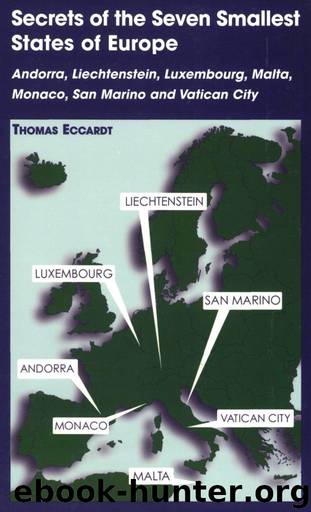Secrets of the Seven Smallest States of Europe: Andorra, Liechtenstein, Luxembourg, Malta, Monaco, San Marino and Vatican City by Thomas M. Eccardt

Author:Thomas M. Eccardt [Eccardt, Thomas M.]
Language: eng
Format: azw3
Publisher: Hippocrene Books
Published: 2004-06-01T04:00:00+00:00
Junior high school.
STATE TOURIST BUREAU OF THE REPUBLIC OF SAN MARINO.
Most of public education in the microstates mirrors the systems of their big sisters, and in fact the local language often suffers because of it. Even though Catalan is the only official language of Andorra, education was given mostly in French and Spanish, as it was in the Catholic schools of France and Spain. The Romagnolo and Monégasque dialects were regularly ignored in the schools of San Marino and Monaco, because the Italian and French school systems were emulated in those microstates. Monaco has introduced its local language as an academic subject, but most classes are still taught in French. Liechtenstein’s schools follow the systems of several German-speaking countries, namely, Germany, Austria, and Switzerland. There, too, no attention is paid to the local Allemanic. The Vatican has no need for a public education system, since the small number of children of the Swiss Guards can go to elementary school in Rome.
Only Malta and Luxembourg seriously promote their native languages through their public school systems. Luxembourgish is used exclusively in preschools, and foreign children are encouraged to learn to speak it. In primary schools, German is introduced, and it gradually becomes the language of instruction. French is the language of instruction in the upper grades and university. By the time they finish their education, most students have mastered speaking, reading, and writing in all three languages. On Malta, Maltese is generally the language of instruction. But due to the influence of 150 years of English rule, English is taught extensively and the English educational system is used.
The result of the public education systems in the microstates of Europe is a very high literacy rate. Literacy is 100 percent in all but San Marino (99.1 percent) and Malta (92.1 percent). Perhaps the lower rate in Malta can be explained by the fact that the use of Maltese, the first language of most of the population, was discouraged for so many years in favor of Italian and English. The microstates maintain a low student to teacher ratio, generally ranging from one teacher for every seventeen students to one per fourteen. Interestingly, San Marino has one teacher for every six students.
Though Malta may have had the most problems with its public education system, it was the first by far to have its own university, founded by Jesuits in 1592. The University of Malta was established as a state institution in 1769, and today it offers courses in all the important fields. And although the Vatican offers no public education for children, it has several private universities, generally for theological studies. These are scattered throughout Rome, and are not housed within the walls of the Vatican. Only toward the end of the twentieth century did most of the other microstates found universities. Before then, most students went abroad to get higher education. Some microstates had specialized schools, such as Liechtenstein’s academy of music, or the University of Southern Europe in Monaco, which offers Masters of Business Administration and the like.
Download
This site does not store any files on its server. We only index and link to content provided by other sites. Please contact the content providers to delete copyright contents if any and email us, we'll remove relevant links or contents immediately.
| Africa | Americas |
| Arctic & Antarctica | Asia |
| Australia & Oceania | Europe |
| Middle East | Russia |
| United States | World |
| Ancient Civilizations | Military |
| Historical Study & Educational Resources |
Room 212 by Kate Stewart(4744)
The Crown by Robert Lacey(4578)
Endurance: Shackleton's Incredible Voyage by Alfred Lansing(4518)
The Iron Duke by The Iron Duke(4127)
The Rape of Nanking by Iris Chang(4025)
Killing England by Bill O'Reilly(3901)
Joan of Arc by Mary Gordon(3797)
Say Nothing by Patrick Radden Keefe(3732)
I'll Give You the Sun by Jandy Nelson(3275)
Shadow of Night by Deborah Harkness(3184)
Hitler's Monsters by Eric Kurlander(3172)
Mary, Queen of Scots, and the Murder of Lord Darnley by Alison Weir(3074)
Blood and Sand by Alex Von Tunzelmann(3061)
Darkest Hour by Anthony McCarten(3019)
Margaret Thatcher: The Autobiography by Thatcher Margaret(2973)
Eleanor & Park by Rainbow Rowell(2948)
Red Famine: Stalin's War on Ukraine by Anne Applebaum(2817)
Book of Life by Deborah Harkness(2727)
The One Memory of Flora Banks by Emily Barr(2688)
